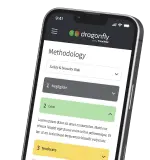It's inevitable, your website will be acting as a hub for your marketing efforts. Whether it's TV, PR, SEO, Google Adwords, billboards, social media marketing, or something else, you will almost certainly be directing your customers back to your website via one shape or form! Let's consider the research:
84% of business buyers will check your website before they buy.
(Source: AquityGroup Research) If you are actively marketing then you should be making sure that your website is geared up nurture people to the point of purchase.
For this article I want to focus on social media marketing and how website development and digital strategies can support a success in this sphere. Here are a few social media marketing examples that you could incorporate today to drive a closer synergy between your website and social media marketing.
Display social sharing icons
Give people a way to like/share/tweet your content right from your website. For example have a go at clicking on these:
This make it much more likely that users will share your content on your target social media platforms. Other buttons exist for the other social media sites such as LinkedIn and Google+.
Embed reviews on your website.
A 2014 Trustpilot survey indicated that a whopping:
77% of British shoppers will consult online reviews before buying a product
In reality most of these review sites are a form of social media, and posts/comments on the more well-known Social Media platforms are just an extension of this.
Reviews on platforms such as TripAdvisor, Google Plus and Facebook can often be embedded within your website alongside your product or service. Doing this builds trust and proves to prospective customers that you are as good as you say that you are.
Embed links to your social channels on your website
If people are arriving at your website from channels other than social media then how are they supposed to know how to engage with you on their favourite social platform? By providing links to your other online profiles you allow your clients to find and engage with you on the one that suits them best.
Facebook tab campaign development (Marketing example)
Let's take a look at a recent marketing campaign launched by WRP on behalf of Fayre and Square pubs: Pair and Square.
This sort of campaign goes above and beyond the typical sharing of photos, videos and status updates. It aims to be much more creative in the way that customers are engaged with. We think the campaign was successful for a few key reasons:
- It is a fun and different game.
- If you match a pair you get an immediate reward of 20% off.
- As a result of the offer being immediate, people share the tab app with friends they know are going to the pub.
- The draw prizes are fun and attractive too, such as Alton Towers tickets, zoo & £100 cinema vouchers.
- If people win then they feel good and are more likely to share the game with their friends.
Find out more about developing a Facebook tab app.
Open Graph meta tags
Warning: Jargon.
Every website on the internet has hidden "meta" information that says something about the page that you cannot see. This meta information drives things such as the description and title of the page as shown in the tab of your web browser. There are all sorts of different things you can put here, but the ones relevant to social media are the "Open Graph" tags. These bits of information tell social media platforms such as Facebook or Linkedin which image or description should be used by default when a page is shared on social media.
These tags are important as they allow you to control the call to action associated with your page when shared. Twitter research around image sharing showed that tweets with an image were 35% more likely to be shared (retweeted) so there is certainly value in having some control over the images and information that people see.
Facebook also has some best practice guidelines for content sharing that include details about open graph tags which are worth getting to grips with.
Create content with social in mind
You have probably heard of content marketing. This is the idea that you should be creating lots of high quality, useful content that you can then share through your channels to market and existing customers. Doing this can build your credibility as an industry expert and can boost your search engine performance as every page you create can be made to target a particular niche keyword.
Here is a great list of different social content creation ideas that you could implement within your business, for example:
- Ensuring Facebook can crawl your website.
- Localizing content using their translation tools.
- Encourage content creators to turn on follow buttons.
- Optimise images for good-looking previews.
- Track metrics using Facebook Analytics.
Blog about social events
Someone ask you a question on Facebook? Provide them with a useful answer? Write about it! Other people probably have the same questions.
Tie social media into your online process
Have a place where clients can log in to access your portal, resources, tools, or maybe an online application? Explore tieing social media sharing into these processes.
A great example of this sort of strategy is the work we did for a dance show website Chance2Dance. Chance2Dance market themselves by getting dance schools involved who want to perform in their shows, these schools can then encourage their dance students to sell tickets to friends and relatives who want to see them perform. To take advantage of social media we wrote a process where students would be eligible for a reward if they shared their ticket purchasing link on social media. The system could then report how many dancers of each school had shared (as a percentage) meaning that the schools that weren't actively sharing on social media could be identified and training be provided where necessary.
This sort of integration work is probably the most profound and creative option of the all as the scope of the things you can do is incredible. Most social media sites have something called an "API". This is like a shop window into the social media site that you can automatically communicate with (e.g. Please give me this info, or here is this info). You can use these API's for all sorts of things, to give you an idea here is a short list of examples (this is by no means a definitive list) :
- Automatically post updates to Twitter.
- Automatically search for tweets that match some specified criteria and notify you when found.
- Pull an authorised users information from twitter.
- Grab a graph showing video views from an authorised users YouTube account.
- Display location information on a Google Map.
- Post a real time update of your current heart beat if you have a smart watch.
- Automatically share content from your favourite news/blog websites.
- Link your website with a user's Google or Email calendar.
- Add Facebook comments to the bottom of your blog posts.
- Show your latest published Instagram photos on your website.
- Tie API's together to make things happen automatically based on certain triggers using the free IF This Then That app.
- etc...
If you would like to talk about how you may be able to implement some of the items discussed in this post then please don't hesitate to contact us.



